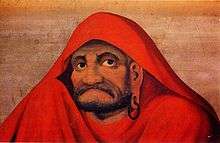Śrāvakayāna
Śrāvakayāna (Sanskrit: श्रावकयान; Pali: सावकयान; traditional Chinese: 聲聞乘; ; pinyin: Shēngwén Chéng) is one of the three yānas known to Indian Buddhism. It translates literally as the "vehicle of listeners [i.e. disciples]". Historically it was the most common term used by Mahāyāna Buddhist texts to describe one hypothetical path to enlightenment. Śrāvakayāna is the path that meets the goals of an Arhat—an individual who achieves liberation as a result of listening to the teachings (or lineage) of a Samyaksaṃbuddha.

Use of the term
Isabelle Onians asserts that although "the Mahāyāna ... very occasionally referred contemptuously to earlier Buddhism as the Hinayāna, the Inferior Way," "the preponderance of this name in the secondary literature is far out of proportion to occurrences in the Indian texts." She notes that the term Śrāvakayāna was "the more politically correct and much more usual" term used by Mahāyānists.[1] "Hīnayāna" (the "lesser vehicle"), however, was used to include both Śrāvakayāna and Pratyekabuddhayāna in contrast to the Mahāyāna.
In Early Buddhist schools
At least some of the early Buddhist schools used the concept of three vehicles including Śrāvakayāna. For example, the Vaibhāṣika Sarvāstivādins are known to have employed the outlook of Buddhist practice as consisting of the Three Vehicles:[2]
- Śrāvakayāna
- Pratyekabuddhayāna
- Bodhisattvayāna
The Dharmaguptakas regarded the path of a śrāvaka (śrāvakayāna) and the path of a bodhisattva (bodhisattvayāna) to be separate. One of their tenets reads, "The Buddha and those of the Two Vehicles, although they have one and the same liberation, have followed different noble paths."[3]
In Mahāyāna traditions
In the 4th century Mahāyāna abhidharma work Abhidharmasamuccaya, Asaṅga describes those who follow the Śrāvaka Vehicle (Skt. śrāvakayanika). These people are described as having weak faculties, following the Śrāvaka Dharma, utilizing the Śrāvaka Piṭaka, being set on their own liberation, and cultivating detachment in order to attain liberation.[4] While those in the Pratyekabuddha Vehicle (Skt. pratyekabuddhayānika) are portrayed as also utilizing the Śrāvaka Piṭaka, they are said to have medium faculties, to follow the Pratyekabuddha Dharma, and to be set on their own personal enlightenment.[4] Finally, those in the Mahāyāna (Skt. mahāyānika) are portrayed as utilizing the Bodhisattva Piṭaka, as having sharp faculties, following the Bodhisattva Dharma, and set on the perfection and liberation of all beings, and the attainment of complete enlightenment.[4]
See also
Notes
- Isabelle Onians, "Tantric Buddhist Apologetics, or Antinomianism as a Norm," D.Phil. dissertation, Oxford, Trinity Term 2001 pg 72
- Nakamura, Hajime. Indian Buddhism: A Survey With Bibliographical Notes. 1999. p. 189
- 《異部宗輪論述記》:謂佛雖在僧中所攝,然別施佛果大,非僧(果大)。於窣堵波興供養業獲廣大果。佛與二乘解脫雖一,而聖道異。無諸外道能得五通。阿羅漢身皆是無漏。餘義多同大眾部執。
- Boin-Webb, Sara (tr). Rahula, Walpola (tr). Asanga. Abhidharma Samuccaya: The Compendium of Higher Teaching. 2001. p. 199-200